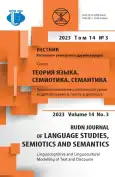Structural and Semantic Features of Oman’s Toponyms as the Reflection of the Country’s Linguistic Situation and Material and Non-Material Culture
- Autores: Al-Rahbi A.M.1, Zarytovskaya V.N.1
-
Afiliações:
- RUDN University
- Edição: Volume 14, Nº 3 (2023): LINGUOCOGNITIVE AND LINGUOCULTURAL MODELLING OF TEXT AND DISCOURSE
- Páginas: 876-892
- Seção: SEMANTICS AND SEMIOTICS
- URL: https://journal-vniispk.ru/2313-2299/article/view/323423
- DOI: https://doi.org/10.22363/2313-2299-2023-14-3-876-892
- EDN: https://elibrary.ru/EZQAIM
- ID: 323423
Citar
Texto integral
Resumo
Toponyms of the Sultanate of Oman so far have not been studied in Russian linguistics in general, and in Russian Arabic studies, in particular. Due to the fact that in Oman there is a specific landscape and peculiar material culture, and the local variation of the Arabic language is characterized by multi-level dialectal peculiarities, the authors assumed that the toponyms of this country should demonstrate certain trends in the place names formation against the backdrop of the common Arabic toponymy. The object of the research is a wide range of toponyms of the Sultanate of Oman - from the names of the largest locations to the ones which are less significant in historical and economic terms, but are of interest from the viewpoint of the linguistic material analysis. The authors examined a large sample of toponyms of various categories, above all, oeconyms and hydronyms; due to the local natural conditions, their share in the country’s toponymy is very significant. The article is aimed at highlighting both the universal, pan-Arabic features and solely the Omani ones in the semantics and algorithms of toponymic word-building of the country. The main local toponyms were considered in terms of their origin, etymology, frequency of formants, morphological composition, as well as in relation to certain semantic fields. This made it possible to systematize the toponyms of Oman and draw a number of conclusions regarding the historically conditioned absence of loan words among Omani toponyms, their complexity with the predominance of specific lexemes characterizing the local landscape, the inclusion of Omani toponyms in lexical groups related to water, as well as the nationally-oriented world picture reflected in characteristics-indices of similar objects of Omani geography. To this end, the researchers used data from subsidiary and related humanitarian areas - geography, history, sociology, ethnopsychology. The work contributes to the study of the semantics of toponyms, comparative toponymy, Arabic lexicology, Russian Arabic studies as well as regional studies.
Sobre autores
Ahmed Al-Rahbi
RUDN University
Email: al_rakhbi_a@rudn.ru
ORCID ID: 0000-0003-4010-1634
PhD in Philology, Senior Lecturer of the Department of Foreign Languages of the Faculty of Humanities and Social Sciences
6, Miklukho-Maklaya Str., Moscow, Russian Federation, 117198Victoria Zarytovskaya
RUDN University
Autor responsável pela correspondência
Email: zarytovskaya-vn@rudn.ru
ORCID ID: 0000-0001-9910-7913
Código SPIN: 4434-9391
PhD in Pedagogical Sciences, Associate Professor of the Department of Foreign Languages, Faculty of Humanities and Social Sciences
6, Miklukho-Maklaya Str., Moscow, Russian Federation, 117198Bibliografia
- Golomidova, M.V. (2019). Artificial nomination in Russian onomastics. Yekaterinburg: Ural State Pedagogical University publ. (In Russ.).
- Perfilieva, N.V., Novospasskaya, N.V. & Da Silva, F. (2017). The Information Component of Toponyms of Guinea-Bissau and Cape Verde. Theoretical and Practical Issues of Journalism, 6(2), 189–203. https://doi.org/10.17150/2308-6203.2017.6(2).189-203 (In Russ.).
- Blair, D. & Tent, J. (2020). Toponym types. A revised typology of placenaming. Sydney: Placenames Australia Inc.
- Superanskaya, A.V. (1973). General theory of a proper name. Moscow: Nauka. (In Russ.).
- Khayitova. F.A. (2020). Principles of Toponyms (Place Names) Classifications. International Journal of Multicultural and Multireligious Understanding (IJMMU), 7(6), 73–79.
- Nabiullina, G.G. (2019). Local geographic terms in the toponyms of the Arabic language. Modern Muslim world, 4, 70. (In Russ.).
- Basik, S.N. (2018) The structure of the onomastic layer in the geocultural space. Scientific review: electronic journal, 4, 138. (In Russ.).
- Mazein, N.V. (2004). Arabic place names. How much there is in this sound. Geography, 13. URL: https://geo.1sept.ru/article.php?ID=200401302 (accessed 12.06.2021). (In Russ.).
- Khairutdinov, D.R. (2007). Arabic geographical terminology. Scientific notes of Kazan State University, 149, 4, 76–82. (In Russ.).
- Kharusi, N. & Salman, A. (2015). In Search of Water. Hydrological Terms in Oman’s Toponyms. Names, 63(1), 16–29.
- Superanskaya, A.V. (1984). What is toponymy? Moscow: Nauka. (In Russ.).
- Martynenko, I.A. & Chesnokova, O.S. (2021) Hybrid Toponyms of Panama as a Reflection of Toponymic Multilingualism. Philological Sciences. Applied linguistics. Bilingualism, 6(2), 221–226. (In Russ.).
- Duri, A.A. Bag̲h̲dād. URL: http://dx.doi.org/10.1163/1573-3912_islam_COM_0084 (accessed 23.05.2021).
- Mohamed Suleiman At-Tayeb (1997). Encyclopedia of Arab tribes. Madinat Nasr: Dar al-fikr al-arabiy. pp. 31–28. (In Arab.).
- Senchenko, I.P. Sultanate of Oman. Legends, legends and facts of history. Saint Petersbourg: Aleteya. (In Russ.).
- Bukharin, M.V. (2009) Arabia, East Africa and the Mediterranean: Trade and Historical and Cultural Relations. Moscow: Vostochnaya Literatura. (In Russ.).
- Bosworth, C.E. (1954–2005). Rustāḳ. Encyclopaedia of Islam. Bearman, Th. Bianquis, C.E. Bosworth, E. van Donzel, W.P. Heinrichs (eds.). Leiden.
Arquivos suplementares









